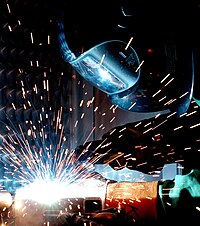
Photo from wikipedia
The dynamics of steady detonation propagation in a two-dimensional, high explosive circular arc geometry are examined computationally using a reactive flow model approach. The arc is surrounded by a low… Click to show full abstract
The dynamics of steady detonation propagation in a two-dimensional, high explosive circular arc geometry are examined computationally using a reactive flow model approach. The arc is surrounded by a low impedance material confiner on its inner surface, while its outer surface is surrounded either by the low impedance confiner or by a high impedance confiner. The angular speed of the detonation and properties of the steady detonation driving zone structure, i.e. the region between the detonation shock and sonic flow locus, are examined as a function of increasing arc thickness for a fixed inner arc radius. For low impedance material confinement on the inner and outer arc surfaces, the angular speed increases monotonically with increasing arc thickness, before limiting to a constant. The limiting behaviour is found to occur when the detonation driving zone detaches from the outer arc surface, leaving a region of supersonic flow on the outer surface. Consequently, the angular speed of the detonation becomes insensitive to further increases in the arc thickness. For high impedance material confinement on the outer arc surface, the observed flow structures are significantly more complex. As the arc thickness increases, we sequentially observe regions of negative shock curvature on the detonation front, reflected shock formation downstream of the reaction zone, and eventually Mach stem formation on the detonation front. Subsequently, a region of supersonic flow develops between the detonation driving zone and the Mach stem structure. For sufficiently wide arcs, the Mach stem structure disappears. For the high impedance material confinement, the angular speed of the detonation first increases with increasing arc thickness, reaches a maximum, decreases, and then limits to a constant for sufficiently large arc thickness. The limiting angular speed is the same as that found for the low impedance confiner on the outer arc surface.
Journal Title: Journal of Fluid Mechanics
Year Published: 2017
Link to full text (if available)
Share on Social Media: Sign Up to like & get
recommendations!